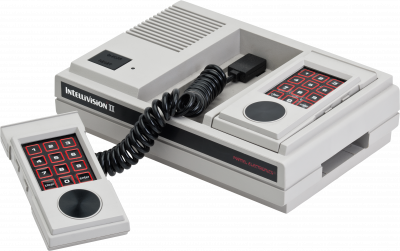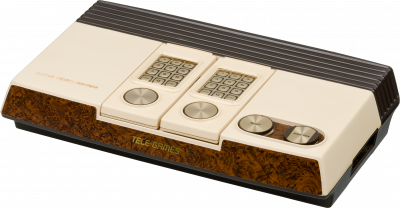Intellivision Mods Wiki
mNo edit summary |
m (edit summary removed) |
||
| (7 intermediate revisions by 2 users not shown) | |||
| Line 6: | Line 6: | ||
[[File:Intellivision.png|400px]] [[File:Intellivision_II.png|400px]] [[File:Sears_Tele-Games_Super_Video_Arcade.png|400px]] | [[File:Intellivision.png|400px]] [[File:Intellivision_II.png|400px]] [[File:Sears_Tele-Games_Super_Video_Arcade.png|400px]] | ||
The Mattel Intellivision is a console from the second generation of video game consoles, initially released to a limited test market in 1979 and receiving a nationwide release in 1980. Based off a chipset from General Instruments, the Intellivision was the first game console to feature a 16-bit CPU and its games generally featured more sophisticated gameplay than those of its competitors. To this end, Mattel engaged in an aggressive marketing campaign starring sports journalist George Plimpton, which pitted the Intellivision directly against the [[Atari_2600:Atari_2600_Mods_Wiki|Atari 2600]]. The console sold fairly well during the early 1980s, enough to the point where Mattel introduced a smaller, cost-reduced system (the Intellivision II) in 1983. Although Mattel ultimately exited the video game market in the aftermath of the 1983 crash, a company known as INTV Corporation acquired the rights to the Intellivision and began selling games and consoles until 1990. The original Intellivision currently enjoys a small but dedicated following, with a steady stream of homebrew titles coming out every year | The Mattel Intellivision is a console from the second generation of video game consoles, initially released to a limited test market in 1979 and receiving a nationwide release in 1980. Based off a chipset from General Instruments, the Intellivision was the first game console to feature a 16-bit CPU and its games generally featured more sophisticated gameplay than those of its competitors. To this end, Mattel engaged in an aggressive marketing campaign starring sports journalist George Plimpton, which pitted the Intellivision directly against the [[Atari_2600:Atari_2600_Mods_Wiki|Atari 2600]]. The console sold fairly well during the early 1980s, enough to the point where Mattel introduced a smaller, cost-reduced system (the Intellivision II) in 1983. Although Mattel ultimately exited the video game market in the aftermath of the 1983 crash, a company known as INTV Corporation acquired the rights to the Intellivision and began selling games and consoles until 1990. The original Intellivision currently enjoys a small but dedicated following, with a steady stream of homebrew titles coming out every year. | ||
</div> | </div> | ||
| Line 28: | Line 28: | ||
* [[Media:Intellivoice_Service_Manual.pdf|Intellivoice Service Manual]] | * [[Media:Intellivoice_Service_Manual.pdf|Intellivoice Service Manual]] | ||
* [[Intellivision:Intellivision Model Differences|Model Differences]] | * [[Intellivision:Intellivision Model Differences|Model Differences]] | ||
* <s> [[Intellivision:Video Output Notes]] </s> | |||
* [[Intellivision:Connector Pinouts|Connector Pinouts]] | * [[Intellivision:Connector Pinouts|Connector Pinouts]] | ||
* <s> [[Intellivision:Region Information|Region Information]] </s> | * <s> [[Intellivision:Region Information|Region Information]] </s> | ||
| Line 48: | Line 49: | ||
<div class="boxed-list center-float clip-corner"> | <div class="boxed-list center-float clip-corner"> | ||
===Repair Guides=== | ===Repair Guides=== | ||
* [[Intellivision:General Troubleshooting]] | |||
* <s> [[Intellivision:Controller Repair|Controller Repair]] </s> | * <s> [[Intellivision:Controller Repair|Controller Repair]] </s> | ||
* [[Replacing Capacitors]] | * [[Replacing Capacitors]] | ||
| Line 58: | Line 60: | ||
| <h3>Flash Carts</h3> | | <h3>Flash Carts</h3> | ||
<ul> | <ul> | ||
<li> [[BackBit Pro]] </li> | |||
<li> [http://ltoflash.leftturnonly.info/ LTO Flash! Multicart] </li> | <li> [http://ltoflash.leftturnonly.info/ LTO Flash! Multicart] </li> | ||
<li> [http://intellivisionrevolution.com/cc3-cuttle-cart-3-development-history Cuttle Cart 3 (discontinued)] </li> | <li> [http://intellivisionrevolution.com/cc3-cuttle-cart-3-development-history Cuttle Cart 3 (discontinued)] </li> | ||
| Line 68: | Line 71: | ||
<li> <s> [[Intellivision:Flashback Controller Modification|Flashback Controller Modification]] </s> </li> | <li> <s> [[Intellivision:Flashback Controller Modification|Flashback Controller Modification]] </s> </li> | ||
<li> <s> [[Intellivision:Controller Adapters]] </s> </li> | <li> <s> [[Intellivision:Controller Adapters]] </s> </li> | ||
<li> < | <li> [https://www.printables.com/model/530236-intellivision-no-cut-av-mod-clip-on-threaded-inser No-Cut Clip-On AV Mod] | ||
<li> [https://console5.com/store/console-cap-kits/mattel.html Capacitor Kit] </li> | |||
</ul> | </ul> | ||
|} | |} | ||
Latest revision as of 09:46, 19 December 2024
The Mattel Intellivision is a console from the second generation of video game consoles, initially released to a limited test market in 1979 and receiving a nationwide release in 1980. Based off a chipset from General Instruments, the Intellivision was the first game console to feature a 16-bit CPU and its games generally featured more sophisticated gameplay than those of its competitors. To this end, Mattel engaged in an aggressive marketing campaign starring sports journalist George Plimpton, which pitted the Intellivision directly against the Atari 2600. The console sold fairly well during the early 1980s, enough to the point where Mattel introduced a smaller, cost-reduced system (the Intellivision II) in 1983. Although Mattel ultimately exited the video game market in the aftermath of the 1983 crash, a company known as INTV Corporation acquired the rights to the Intellivision and began selling games and consoles until 1990. The original Intellivision currently enjoys a small but dedicated following, with a steady stream of homebrew titles coming out every year.
General Information
Technical Information
General Mods
Repair Guides
Flash Carts |
Replacement Parts |
Other |


